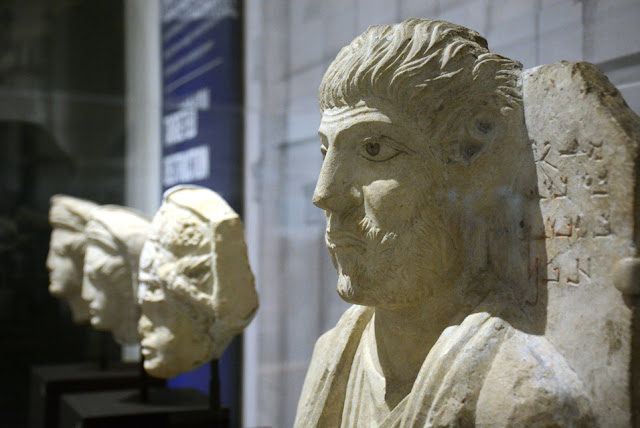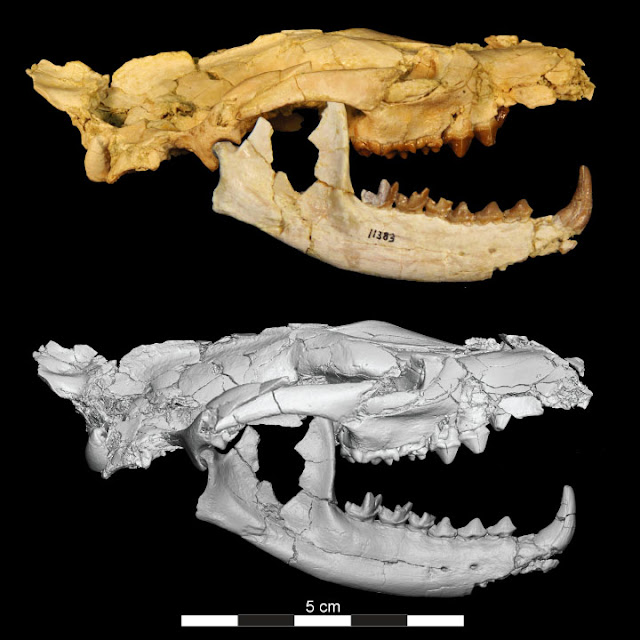Nimrud. Aleppo. Palmyra. Ebla. These ancient sites and many others in Iraq and Syria have found their way to the top of international news today, as the destruction of cultural heritage becomes both a by-product and a tactic of ongoing war throughout the region.
 |
Cultures in the Crossfire: Stories from Syria and Iraq features a set of 1st- and 2nd-century CE funerary portraits from
Palmyra, which demonstrate the complexity and richness of Palmyrene identity [Credit: Penn Museum] |
What is really at stake? Why does it matter? What is the human story that accompanies this unprecedented loss? And what is being done to prevent further loss of the material culture, vast human history, and diverse cultural identities in the region of the world long known as the “cradle of civilization”?
Cultures in the Crossfire: Stories from Syria and Iraq, a new special exhibition at the Penn Museum opening April 8, considers these questions. Developed in conjunction with the Museum’s Penn Cultural Heritage Center, the exhibition explores the rich cultural heritage, human diversity, and achievements—as well as the movements and displacements of people and objects caught in the crossfire—through more than 50 objects from the Museum’s exceptional Near East and Mediterranean collections, as well as a range of Arabic manuscripts from the University of Pennsylvania Libraries, music and sounds, and documentary film clips. Contemporary artwork from Syrian artist Issam Kourbaj, interwoven throughout the exhibition, provides an art intervention—a modern-day response to the artifacts and exhibition themes.
The exhibition puts the spotlight, too, on current work being done by the University of Pennsylvania and the Smithsonian Institution in conjunction with individuals and groups in the Middle East to help combat the loss of irreplaceable cultural heritage. the exhibition runs through November 26, 2018.
Exploring Identities, Scholarship, Daily Life, and the Movement of PeopleThe exhibition surveys the cultural diversity of the region through the millennia, where Arabs, Kurds, Arameans, Assyrians, Armenians, Circassians, Turkmens, Sunnis, Shias, Druze, Ismailis, Christians, Jews, and Yazidis are among the many peoples with unique histories and claims for the preservation of their heritage. The region has rich diversity—and much of the ethnic targeting and cultural heritage destruction has been sectarian in nature. Palmyrene funerary reliefs, a Hebrew tombstone, an eye idol, incantation bowls, and a manuscript page from a Qur’an provide tangible evidence of a long history of religious and ethnic diversity in the region.
Unfathomable to many Americans, in the Middle East people go about their daily lives alongside ancient ruins, inhabit cities that date back millennia, and value their historic neighborhoods and markets because of their association with the past. Everyday items, some thousands of years old, speak to traditions handed down from generation to generation: a drum, a rattle, a pot, a bowl and a ladle, a lute and a trumpet, a Kurdish doll. These items provide insight into the continuity of household and family life.

 |
|
The fertile crescent has played a key role in intellectual developments for more than 5,000 years, and the exhibition highlights the development of writing and literature, advances in education, mathematics, astronomy, and medicine, philosophy, and the arts. A clay tablet bearing early writing, and ancient cylinder seals and stamps for signing documents, are among the Penn Museum collection objects that tell this story. From the University of Pennsylvania’s Kislak Center for Special Collections, Rare Books and Manuscripts, a selection of illustrated manuscripts on complex mathematics, botany, medicine and surgery, music theory, astronomy, and more, bear witness to the intellectual flourishing in the region.
Long a land of cross-cultural interactions, the region that is now Iraq and Syria has experienced waves of migrations of people and been a trading center throughout history. Gold ornaments, ivories, coins, glass pitchers and containers, and a mosaic panel are among the ancient materials that speak to a long history of cultural interaction, trade, influence, and migration under the rule of multiple empires.
A Contemporary Perspective: Through the Art of Issam KourbajSyrian-born artist Issam Kourbaj offers an “art intervention” via stand-alone artworks installed throughout the exhibition. Taken together, the seven works create a space to contemplate the tragic current events in the region. From Strike i, ii, and iii, a series of video installations featuring a performance of burning matchsticks, to Dark Water, Burning World (2016), an installation of boats repurposed from old bikes’ mudguards and inspired by 5th century BCE Syrian boats, to Seed (2016), an installation of a soft children’s toy caught in a hand grinder clamped to a tall stand, with seeds below, Kourbaj’s works reflect upon the human suffering, despair, struggle—and hope—in his native land.
Mr. Kourbaj’s work has been widely exhibited internationally. Sound Palimpsest, a collection of his sketches, inspired in part by the Epic of Gilgamesh and also by language, war and memory, was acquired by the British Museum in 2008. His current traveling installation, Another Day Lost, based on Syrian refugee camps, was exhibited in London, New York City, Dubai, Cambridge, UK, Budapest, and Philadelphia, in 2015 and 2016. He was trained at the Institute of Fine Arts in Damascus, the Repin Institute of Fine Arts in Leningrad (St. Petersburg), and at Wimbledon School of Art (London).
Taking ActionThe Museum’s Penn Cultural Heritage Center has been involved in a number of projects over the years, working closely with Syrians and Iraqis to identify, monitor, and find ways to preserve cultural heritage of importance to local communities and at risk of destruction. It is not an easy task. Woven throughout the exhibition are stories of some of this work: at Ebla in Syria; at Erbil, and Dohuk in Iraqi Kurdistan; at a mosaic museum in Ma’arra, Syria; and with a refugee community in northern Syria.
Stewardship of Museum collections is another kind of action to preserve cultural heritage; in the gallery adjacent to Cultures in the Crossfire, the Penn Museum reopens its popular In the Artifact Lab conservation exhibition and program with a new name and an expanded focus: The Artifact Lab: Conservation in Action. Beginning April 8, Museum conservators will be concentrating on ancient art and artifacts of the Middle East, working on objects in a lab behind glass, with open window times when guests can ask questions several times each day.
About the Penn Cultural Heritage CenterDedicated to supporting cultural heritage initiatives, the Penn Cultural Heritage Center (PennCHC) at the Penn Museum brings considerable experience in training, capacity building, and basic research about cultural heritage and cultural policy. It has led several projects in conjunction with the U.S. government, including a research partnership with the U.S. Department of State’s Mission to UNESCO to increase the empirical information known about the World Heritage program as it exists in the United States and abroad. PennCHC’s capabilities are enhanced by the world-class archaeological and anthropological faculty at the University of Pennsylvania and the curators of the Penn Museum. Dr. Brian Daniels, Director of Research and Programs at the Penn Cultural Heritage Center, is the Center’s principal coordinator for the Safeguarding the Heritage of Syria and Iraq Project (SHOSI).
Source: Penn Museum [April 08, 2017]Nimrud. Aleppo. Palmyra. Ebla. These ancient sites and many others in Iraq and Syria have found their way to the top of international news t...









